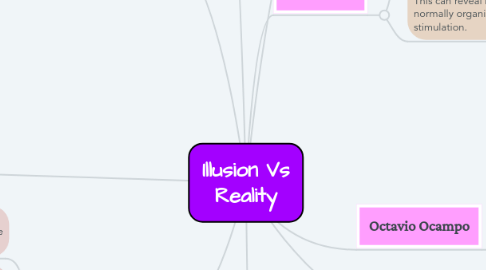Illusion Vs Reality
by Libberty Gibson

1. Distortion
1.1. Distortion is the alteration of the original shape of something. In communications and electronics it means the alteration of the waveform of an information-bearing signal, such as an audio signal representing sound or a video signal representing images, in an electronic device or communication channel.
1.2. Distortion is basically when something doesnt match up with the original way of it being. for example looking in a illusion mirror, such as ones youll see at a fun fair house, it causes you to see a reflection of you and your surroundings that is different to the real thing.
1.3. distortion can interfere with sound, and sight. it can cause sounds to be played back differently than they were recorded.
2. Colourblind
2.1. colourblindness is being unable to distinguish certain colours, or any colours at all. This makes you see the world differently to others. there are 3 main types.
3. Red-Green colourblindness
3.1. Deuteranomaly is the most common type of red-green colour blindness. It makes green look more red.
3.2. Protanomaly makes red look more green and less bright.
3.3. if you have both protanopia and deuteranopia both make you unable to tell the difference between red and green at all.
4. Blue-Yellow colourblindness
4.1. Tritanomaly makes it hard to tell the difference between blue and green, and between yellow and red.
4.2. Tritanopia makes you unable to tell the difference between blue and green, purple and red, and yellow and pink. It also makes colors look less bright.
5. Monochromacy
5.1. this is complete colour blindness meaning you cant see any colour at all
5.2. this is very rare in humans but it can happen and you will only see in black and white.
6. colour
6.1. without colour we would see everything different than it is. some one with colour blindness will perceive eveything differently. also its not an illusion and they do really see things like that, it still is different to what the world actually looks like.
7. Emotions
7.1. Arrogance: exaggerating or disposed to exaggerate one's own worth or importance often by an overbearing manner
7.2. this could be seen a phycological illusion. if you are brought up to believe you are better than everyone else then you could be arrogant and think you have a higher social status than you do. alternetively, if you were emotionally abused then you could believe you have worth less than others.
7.3. However even if you are of a higher social status, that doesnt mean you better than another individual and you cant treat them differently.
8. Illusion
8.1. an instance of a wrong or misinterpreted perception of a sensory experience.
8.2. An illusion is a distortion of the senses. This can reveal how the human brain normally organises and interprets sensory stimulation.
9. Optical illusions
9.1. An optical illusion is an illusion caused by the visual system and characterized by a visual percept that arguably appears to differ from reality.
9.2. There are three main types of optical illusions including literal illusions, physiological illusions and cognitive illusions.
10. Literal illusion
10.1. A literal illusion is when the image you see is different from the images that it makes up.
10.2. The end result you see in a literal illusion is based on your perception. Both images exist.
10.3. Basically this means that an image can look like one thing from one perspective but if you change your perspective then you can see a completely different image. however both images are still there
11. Physiological
11.1. they reply on the over stimulation of the brain’s senses.
11.2. At first glance, a two-dimensional figure looks like it’s three-dimensional
11.3. Typically these are images with a lot of shapes and colour. when you look at the image, it appears to be moving it wobbling but in reality it is'nt.
12. Cognitive
12.1. hese illusions rely on what the subconscious mind thinks and how it relates one object to another.
12.2. A cognitive optical illusion uncovers what your brain infers and understands about something that has not been explained.
12.3. An example of this would be the vase image. originally you might see a vase in the middle of the image but if the images colours are flipped and focuses your eyes to the outside, you'll see 2 faces.
13. Bridget Riley
13.1. Bridget Louise Riley is an English painter known for her optical illusion art paintings.
13.2. Her optical illusions artworks make the two-dimensional surface of the painting appear to move, vibrate, and sparkle.
14. Octavio Ocampo
14.1. Octavio Ocampo is a Mexican surrealist portrait painter.
15. Salvador Dalí
15.1. Salvador was a Spanish surrealist artist
15.2. his works included painting, graphic arts, film, sculpture, design and photography
16. ARTISTS


